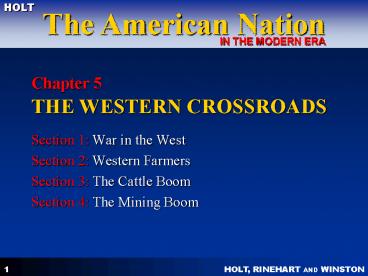Chapter 5 THE WESTERN CROSSROADS - PowerPoint PPT Presentation
Title:
Chapter 5 THE WESTERN CROSSROADS
Description:
Chapter 5 THE WESTERN CROSSROADS Section 1: War in the West Section 2: Western Farmers Section 3: The Cattle Boom Section 4: The Mining Boom Objectives: Why did the U ... – PowerPoint PPT presentation
Number of Views:150
Avg rating:3.0/5.0
Title: Chapter 5 THE WESTERN CROSSROADS
1
Chapter 5 THE WESTERN CROSSROADS
- Section 1 War in the West
- Section 2 Western Farmers
- Section 3 The Cattle Boom
- Section 4 The Mining Boom
2
Objectives
Section 1 War in the West
- Why did the U.S. government create the American
Indian reservation system? - What were the sources of conflict between the
Plains Indians and the U.S. government? - How did Chief Joseph, Geronimo, and Sarah
Winnemucca respond to whites treatment of
American Indians? - How did the U.S. government try to assimilate
American Indians?
3
The reservation system
Section 1 War in the West
- created to serve desire for farmland and gold
- gave government control of American Indians
- provided opportunity for assimilation of American
Indians
4
The Plains Indians and the U.S. government
Section 1 War in the West
- conflicts over land and reservations
- conflicts over broken promises and treaties
- conflicts over the Ghost Dance
5
Chief Josephs response
Section 1 War in the West
- agreed to move tribe to a reservation
- fled from the U.S. Army and eventually surrendered
6
Geronimos response
Section 1 War in the West
- fled reservation with his tribe raided
settlements - eventually surrendered
7
Sarah Winnemuccas response
Section 1 War in the West
- called attention to problems
- made speeches participated in political
activities
8
Assimilation attempts
Section 1 War in the West
- establishment of reservations
- creation of Indian schools
- passage of the Dawes Act
9
Objectives
Section 2 Western Farmers
- How did the U.S. government promote economic
development in the West? - Why did people migrate west?
- How did the environment influence farming
practices and daily life in the West? - What difficulties did farm families face on the
Great Plains?
10
Promotion of economic development
Section 2 Western Farmers
- Homestead Act permitted any citizen or intended
citizen to have 160 acres of land. - Pacific Railway Act gave lands to railroad
companies to develop the transcontinental
railroad. - Morrill Act provided more than 17 million acres
of land whose sale was to finance agricultural
and engineering colleges.
11
Migration west
Section 2 Western Farmers
- White Americans sought cheaper lands or wanted to
make a new start. - African Americans wanted to escape persecution in
the South. - Scandinavians had America Fever.
- Irish moved west after building railroads.
- Russian Mennonites moved after Russian czar ended
their exemption from military service. - Chinese came during Gold Rush and turned to
farming.
12
Environmental influence
Section 2 Western Farmers
- Lack of water and strong winds led to dry farming
and irrigation. - Lack of trees led to use of buffalo manure as
fuel and building material. - Harsh winters led to use of new varieties of
wheat that withstood the weather.
13
Difficulties for farm families
Section 2 Western Farmers
- poor housing
- blizzards and cold weather
- droughts
- insects
- prairie fires
- backbreaking work
14
Objectives
Section 3 The Cattle Boom
- How did cattle and sheep ranching develop in the
West? - What was life like for cowboys and residents of
cattle towns? - What were ranches like?
- Why did the cattle boom on the open range end?
15
Development of cattle ranching
Section 3 The Cattle Boom
- introduction of the Texas longhorn
- expansion of eastern beef market
16
Development of sheep ranching
Section 3 The Cattle Boom
- introduced by Spanish
- also done by American Indians
- market expansion sparked by Gold Rush
17
Cowboy life
Section 3 The Cattle Boom
- demanding working conditions
- isolation
- trail drives
18
Town life
Section 3 The Cattle Boom
- busy from spring to fall from cattle drives
- businesses attracted by the money that cowboys
received at end of drive - families followed businesses
19
Ranches
Section 3 The Cattle Boom
- hard work for both genders
- lonely
- centered around roundup
20
End of the cattle boom
Section 3 The Cattle Boom
- cattle glut
- invention of barbed wire
- depletion of grass
- bad weather
21
Objectives
Section 4 The Mining Boom
- What role did mining play in bringing more people
west? - How did the arrival of families change life in
mining camps? - Why did large companies take over most mining
operations, and how did this change the lives of
miners?
22
Role of mining
Section 4 The Mining Boom
- Mining attracted people to the West by presenting
the possibility of great wealth.
23
Arrival of families
Section 4 The Mining Boom
- Families brought stability and transformed
temporary towns into permanent ones. - Families brought law and order.
- Families established churches, newspapers,
schools, and cultural establishments.
24
Takeover by large companies
Section 4 The Mining Boom
- It was expensive to mine the deep, less
accessible deposits. - Technology rather than luck required to locate
deposits. - Miners became laborers for corporations rather
than self-employed individuals. - Working conditions in mines were dangerous.
- Some miners formed unions to get better wages and
working conditions.































